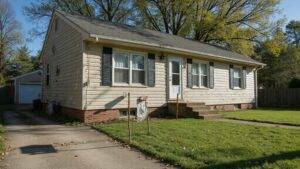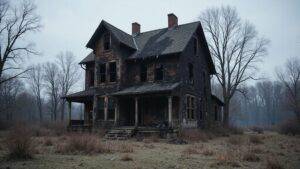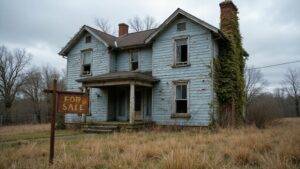Selling a hoarder house is not easy. Most buyers hesitate because of the clutter, repairs, and unknown costs. You must decide whether to sell as-is or invest time and money into repairs.
This choice can feel stressful. Selling as-is is faster but brings a lower price. Repairs can mean a higher sale price, but also more effort, time, and risk. The best way to sell a hoarder house depends on your priorities for time, money, and stress.
This blog will guide you through your options and help you make the right choice for your situation. You will get clear steps to solve your hoarder house selling challenge.
Key Takeaways
- Selling as-is attracts cash buyers and investors, but usually results in a sale price 10–30% below market value.
- Making repairs can increase buyer interest and final sale price, but requires significant time and upfront costs.
- As-is sales offer faster closings and avoid the hassle of staging or extensive cleaning.
- Repairs help meet legal disclosure requirements and reduce the risk of buyers backing out after inspections.
- Weigh repair costs and potential return on investment by comparing recent sales and obtaining detailed contractor quotes.
Understanding What Qualifies as a Hoarder House

A hoarder house is a home with too many items piled up, making it hard or unsafe to live there. These homes often have blocked walkways, rooms you cannot enter, or exits you cannot use. Mold, pests, and fire risks are common in these conditions.
The National Study Group on Chronic Disorganization says these homes may need special cleaning. Severe clutter and sanitation problems can cause structural damage over time. If you notice strong odors or cannot access certain areas, your house may qualify. If a house remains on the market for a long time, buyers may develop price stigma that can make selling the property even harder.
Cleanup crews are often needed to restore a hoarder house. If the home does not meet local codes, you must fix these issues before selling. Proper handling of offers, financing, and inspections ensures a smoother and more efficient selling process for these challenging properties. Understanding these points helps you choose the right steps for preparing the home.
Common Challenges When Selling a Hoarder House
Selling a hoarder house comes with several challenges. Buyers often worry about health risks, bad smells, and hidden damage. Clutter can make it hard for them to see the home’s value.
If rooms are blocked, showings and inspections become difficult. Emotional ties can slow down sorting through personal items. You may also have trouble finding space for things you want to keep. In addition, sellers need to be aware of Virginia’s disclosure rules to ensure legal compliance and avoid future disputes.
If you address these issues early, you can attract more buyers. Focus on safety and honesty during the selling process. Clear communication will help make the sale smoother. You might also consider selling as-is with a cash buyer, who can purchase the property without requiring repairs or clean-out, reducing much of the hassle involved.
Assessing the Condition of the Property

Start by identifying any safety hazards, such as structural issues or biohazards, that could impact buyers and inspectors. You’ll need to estimate repair costs accurately, as the average hoarder house may require investments ranging from $10,000 to $50,000 to bring it up to code. With these factors in mind, evaluate the market value by comparing similar properties in your area and adjusting for the property’s unique challenges.
It’s also important to disclose known issues and have proper documentation, as some states like Virginia require strict adherence to disclosure laws that help avoid potential legal trouble during the sale. Using recent sales data for competitive pricing can help you better estimate value and attract faster offers, even for challenging properties like a hoarder house.
Identifying Safety Hazards
Even small amounts of hoarding can create safety risks in a home. These risks can lower a property’s value and make it harder to sell. A careful safety check is needed before listing a hoarder house.
You should ignore any personal feelings about the home. Focus on problems that could stop buyers from making an offer. If hazards are present, buyers may lose interest quickly.
Common issues include blocked exits, mold, pests, and possible structural harm. Blocked pathways can break fire safety rules and slow emergency help. Mold and pests may stay hidden under clutter and cause health problems.
Structural damage may come from too much weight or long-term neglect. If you find these risks, you must fix them before selling. Addressing hazards can help you sell the house faster and for a better price.
Estimating Repair Costs
To estimate repair costs, list all needed repairs and services for the property. Junk removal is often the largest initial expense in a hoarder house. Professional junk removal companies may charge $200 to $600 per truckload, so gather several quotes.
If you want to save any items, consider the cost of storage solutions. Cleaning, pest control, and repairs to walls, floors, or systems like plumbing and electrical should be included. If there are signs of water leaks or mold, add those repair costs as well.
Document each repair and get estimates from licensed contractors. This approach helps you understand the total costs before deciding to sell. If you follow these steps, you can avoid surprises later.
Evaluating Market Value
To find the true value of a hoarder house, start by checking its current condition. Consider how clutter and needed cleaning affect what buyers might pay. If the house needs a lot of work, its price will be lower than similar homes in better shape.
Look at recent sales of nearby homes with similar features and sizes. Adjust your estimate if those homes were cleaner or in better condition. Use facts and numbers, not guesses, to compare values.
If you are unsure, talk to a real estate agent or appraiser who knows about distressed properties. They can help you understand what repairs and cleanup will cost. Their advice can help you set a fair and realistic price.
Pros and Cons of Selling As-Is

When you sell a hoarder house as-is, you can close much faster but should expect a lower sale price and a smaller pool of interested buyers. National data shows as-is homes often sell 10-20% below market value, but they typically spend fewer days on the market.
In Virginia, sellers are legally required to disclose known defects, such as structural issues, water damage, or major system failures, to ensure transparency and prevent potential legal complications. Weigh these factors carefully to choose the best strategy for your situation. It’s important to note that legal risks can increase significantly if you fail to properly disclose defects when selling as-is, making transparency even more crucial.
Faster Sales Process
Selling a hoarder house as-is can make the sales process much faster. You avoid repairs and staging, saving time and effort. This method helps you list your house quickly.
Investors and cash buyers often prefer as-is homes. They do not worry about property condition and usually pay cash. If you want a fast sale, these buyers are ideal.
Traditional buyers need appraisals and loan approvals, which may cause delays. Selling as-is often skips these steps. You get a smoother, quicker transaction.
If speed and simplicity matter most to you, selling as-is is a good choice. This approach removes many common obstacles. You can move forward sooner with your plans.
Lower Sale Price
Selling a hoarder house as-is usually means you will get a lower sale price. Most buyers expect to spend money on repairs, so they offer less. Visible clutter and lack of staging also make it hard for buyers to see the home’s value.
If you sell as-is, you could receive 10-30% less than market value. Emotional ties to the property may make these offers seem unfair. It is important to stay practical and focus on your goals.
Here is a summary of the main factors:
| Factor | Impact on Sale Price |
|---|---|
| No staging | Reduces buyer interest |
| Needed repairs | Lowers perceived value |
| Emotional ties | May affect decision making |
| Quick sale | Often means less profit |
Staying realistic helps you make the best decision for your situation.
Limited Buyer Pool
Selling a hoarder house as-is reduces your potential buyers. Most buyers want clean, move-in ready homes. If you skip repairs and cleaning, only a few buyers will show interest.
Retail buyers usually avoid homes with clutter and damage. Investors and flippers are more likely to make offers, but they pay less. If your home looks neglected, buyers expect hidden problems.
You should know your buyer pool before listing the house. Understanding these limits helps you plan your sale. If you want a faster sale, consider the trade-offs.
Pros and Cons of Selling With Repairs

Selling a hoarder house with repairs can raise your sale price and attract more buyers. Repairs often make the home look cleaner and more organized. If you fix problems and add storage, buyers may see the house as more useful. Taking care of repairs before selling also helps with property disclosure requirements, which are especially important in Virginia.
Repairs can cost a lot of money and take extra time. You might find hidden damage that leads to bigger expenses. If the housing market changes, you could wait longer to sell.
You should think about your budget and timeline before starting repairs. If you have help from others, cleaning and repairs may be easier. Weigh these pros and cons before making a decision.
Some cosmetic flaws, such as minor scratches or carpet stains, can often be left as-is to save on unnecessary expenses when selling.
Calculating Potential Return on Investment
To maximize your profit, you’ll need to estimate repair costs and compare them to the projected market value after renovations. Use recent sales data for similar homes in your area to set realistic expectations. This approach lets you make informed decisions on whether investing in repairs will yield a worthwhile return.
When weighing your options, keep in mind that buyer perception of foundation or structural issues can significantly lower offers, making transparent communication crucial for protecting your bottom line. Don’t forget to factor in the importance of proper legal navigation when calculating your potential return, since legal compliance and thorough disclosure can directly impact the final sale price and help you avoid costly disputes.
Estimating Repair Costs
You must know repair costs before listing a hoarder house. Repair expenses affect your possible profit. If you do not check these costs, you may lose money.
Get several quotes from licensed contractors for main repairs. Focus on electrical, plumbing, and structural work first. If you ignore these, buyers may avoid your house.
List repairs by their importance to safety and building codes. Cleaning and basic staging can help your house look better. If you estimate costs carefully, you can plan your sale with confidence.
Projecting Market Value
Knowing your repair costs helps you predict the market value of a hoarder house. You can also estimate your possible profit. This lets you decide if repairs are worth the effort.
Compare recent sales of similar homes in your area. Make sure to look at their condition and sale prices. These details show how much buyers might pay for your house.
If you invest in repairs, consider how changes like cleaning, staging, or landscaping can affect buyers’ interest. Home improvements may boost the sale price. However, you should check if the added value is more than your expenses.
Use clear market data to set your asking price. Subtract repair and selling costs to find your likely profit. This approach helps you choose between selling as-is or after repairs.
Determining Your Target Buyer

People most likely to buy a hoarder house are investors, flippers, and bargain shoppers. These buyers look for homes with potential, not perfect condition. If you target these groups, you increase your chances of selling.
Investors often seek properties they can renovate for profit. House flippers want homes they can update and resell quickly. Cash buyers may overlook clutter if they see a good deal. Assessing the local market demand and understanding buyer profiles in your area can help you tailor your sales strategy for the best results.
Most distressed homes sell to investors or cash buyers. These buyers usually do not care about mess or cosmetic issues. If you focus on their needs, you can sell your hoarder house faster.
Many local Waynesboro buyers are able to purchase hoarder homes as-is for cash, offering a faster and less stressful sale compared to traditional methods.
Legal and Disclosure Requirements
You must follow legal and disclosure rules when selling a hoarder house. Most states require you to tell buyers about any known problems. These include structural damage, pest issues, or hazards often found in hoarder homes.
If you do not share this information, buyers could sue or cancel the sale. You should create a clear statement that lists all current issues. Include any code violations and provide repair estimates if you have them.
Honest disclosures protect you from legal problems and help buyers trust you. According to the National Association of Realtors, most buyers want full details about the property. If you are transparent, you are more likely to complete the sale without disputes later.
Consulting a legal or real estate expert can also ensure you comply with important disclosure requirements, especially if your sale has debt-related factors or unusual property conditions.
Working With Real Estate Agents Experienced in Hoarder Homes
Real estate agents with hoarder home experience know how to handle these unique challenges. They can market your property to buyers who understand its condition. These agents are skilled at making hoarder homes look appealing.
A good agent has sold hoarder or distressed homes before. He or she knows how to stage rooms simply to show their potential. Neighborhood data helps them set a fair price.
If you work with the right agent, your home will reach the best buyers. You can sell faster and for a better price. This is true whether you sell as-is or after making repairs.
Strategies for Cleaning and Decluttering
Start by tackling the most critical cleanup areas that impact safety and buyer impressions. Adopt efficient decluttering techniques, such as sorting items by category and using the “keep, donate, discard” method, to speed up the process. Research shows homes that undergo structured decluttering sell faster and for higher prices.
Prioritizing Essential Clean-Up
Prioritizing essential clean-up helps sell a hoarder house faster and for a better price. Buyers and inspectors notice clean walkways and open rooms first. If you focus on these areas, you increase your chances of getting offers.
Clear entryways and main living spaces to make a good impression. Remove trash and clutter from areas people use most. If you address odors and stains, you help avoid turning buyers away.
You do not need to clean everything perfectly. Target the areas that matter most for the best results. If you work strategically, you will see positive changes quickly.
Efficient Decluttering Techniques
Efficient decluttering techniques help you clean up quickly and feel less stressed. Start by working one room at a time. Use the “keep, donate, discard” method to sort items.
If you break big tasks into smaller steps, you will get more done. Sort items fast and do not second-guess your choices. Temporary storage bins or shelves can help organize things you want to keep.
Label each container clearly if you plan to sort again later. You could ask friends or family to help, as teams work faster. If you remove large or dangerous items first, you will make the space safer and more appealing.
Estimating Repair Costs and Timelines
Estimating repair costs and timelines is important for any hoarder house. You must know how much time and money the work will take. This helps set clear expectations and prevents surprise expenses.
Start by checking for structural, electrical, and plumbing problems. You should also plan for deep cleaning, pest control, and storage improvements. If the house has many items, sorting them may slow down the process.
If you want accurate estimates, ask licensed contractors for detailed bids. Use recent sales of similar homes to compare costs. Delays may happen if there is hidden damage or permit issues.
Always list repairs by priority to focus on urgent needs first. Get several estimates to ensure fair prices. Allow extra time for decluttering and solving storage problems.
Marketing a Hoarder House to Investors
Investors want properties with strong returns, so market a hoarder house by focusing on its profit potential. Highlight its future value after repairs and mention its location. Clearly state the current condition to build trust.
Virtual tours can show the property without cleaning it first. This saves time and lets investors see the real situation. If you use “before and after” renovation ideas, investors can better imagine the finished product.
List the house on investment websites and cash buyer lists. Attend local real estate meetups to reach more investors. If you use targeted marketing, you will attract serious buyers who act fast.
Navigating Inspections and Appraisals
Inspections and appraisals are important steps when selling a hoarder house. These steps can lower a home’s value if it looks cluttered or damaged. Sellers should prepare carefully to avoid negative outcomes.
Owners should clear main pathways before the inspection. Inspectors must reach key areas like electrical panels and HVAC units. If they cannot, reports may be unfavorable.
Safety is another top priority during this process. Removing hazards can help the inspection report look better. Appraisers may also value the house higher if they see a safe environment.
Minimal staging can help highlight the home’s strengths. Buyers and appraisers may see more potential if clutter is removed. If owners focus on these areas, they may improve their sale results.
Negotiating Offers and Closing the Sale
When you get offers on a hoarder house, review each one carefully. Look at the price, buyer’s qualifications, and any conditions. Compare these with your pricing plan and recent local sales.
You can use marketing methods, like online ads or investor contacts, to attract more offers. If an offer does not meet your needs, send a counteroffer. Always focus on what makes your house valuable, especially for buyers ready to do repairs.
Quick and clear communication helps keep deals moving. If you accept an offer, work with your agent to finish the sale smoothly. Make sure all steps happen on time for a successful closing.
Conclusion
If you want to sell a hoarder house, you have two main options. If you sell as-is, you can save time but may receive a lower offer. If you make repairs, you might get a higher price but will spend more time and money.
If you want to avoid the hassle of repairs, consider selling to a company that buys houses for cash. Cash buyers like us can close quickly and handle all the cleanup. This option is ideal if you want a fast, easy sale.
If you are ready to sell your hoarder house, we can help. At Align Real Estate Solutions, we buy houses for cash in any condition. Contact us today to get a fair offer and start your stress-free sale.
Author
-

Zach Koops is co-founder and Real Estate Success Manager at Align Real Estate Solutions, serving homeowners across Virginia since 2024. With a passion for real estate and a heart for people, Zach has built his career around helping sellers navigate tough situations—foreclosure, inheritance, relocation, repair-overload—with clarity and compassion. He’s known for being straightforward, steady under pressure, and deeply invested in relationships. Outside of work, he spends his time as a husband and father, enjoys the outdoors in Shenandoah Valley, loves singing on stage, and constantly seeks growth through reading and new experiences.









